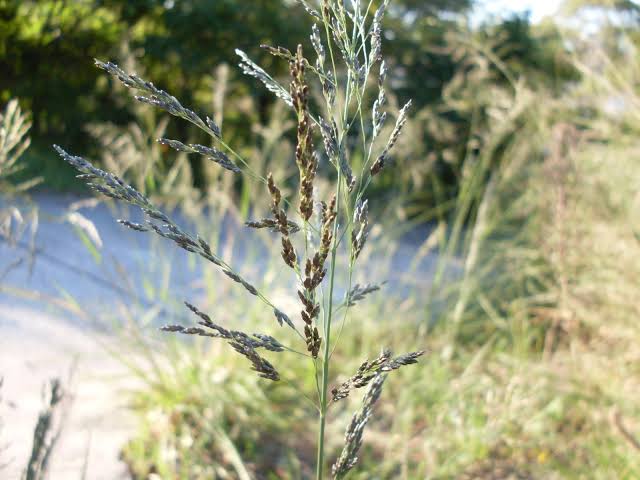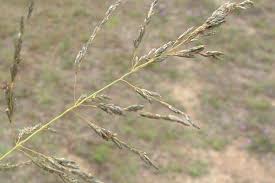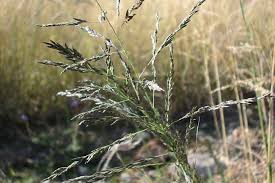Weeping lovegrass (Eragrostis curvula) is a special kind of grass that grows in many places around the world. This grass is known for its long, slender leaves and its ability to adapt to different environments. People often appreciate it for its beauty and usefulness in various ways.
One interesting thing about Weeping lovegrass is its unique appearance. Its leaves are thin and can grow quite long, giving the grass a graceful and weeping appearance. This characteristic makes it stand out in fields and landscapes, adding a touch of elegance to the surroundings.
This type of grass is not just about looks; it also serves important purposes. Farmers often use Weeping lovegrass for grazing animals. Animals, like cows and sheep, find it tasty and nutritious. It provides a good source of food, helping them stay healthy and strong. This makes Weeping lovegrass a valuable resource for farmers who want to ensure their livestock is well-nourished.
Moreover, Weeping lovegrass is known for its resilience. It can grow in different types of soil and withstand various weather conditions. This adaptability makes it a reliable plant in areas where other grasses might struggle to thrive. It’s like a tough and determined friend in nature, always ready to face challenges and keep growing.
In addition to its agricultural uses, Weeping lovegrass plays a role in preventing soil erosion. The roots of this grass form a network in the soil, holding it together. This helps in preventing the soil from being washed away during heavy rains, which is crucial for maintaining the health of the land.
Gardens and landscapes benefit from the aesthetic appeal of Weeping lovegrass. Its weeping form and vibrant green color make it a popular choice for ornamental purposes. People enjoy planting it in gardens to enhance the visual appeal and create a soothing atmosphere.
Weeping lovegrass, scientifically known as Eragrostis curvula, is not just a pretty face in nature. Its unique appearance, adaptability, and multiple uses in agriculture and landscaping make it a valuable and appreciated grass. Whether providing nutritious forage for animals, preventing soil erosion, or simply adding beauty to a garden, Weeping lovegrass stands tall as a versatile and resilient member of the plant kingdom.
Read Also: The Appearance and Features of Boa Constrictors
How To Grow Weeping Lovegrass (Eragrostis curvula)

Growing Weeping lovegrass (Eragrostis curvula) can be a rewarding experience. Here’s a simple guide to help you cultivate this versatile grass:
1. Selecting the Right Location: Choose a sunny location with well-drained soil for planting Weeping lovegrass. This grass thrives in full sunlight, so ensure the selected area receives adequate sunlight throughout the day.
2. Soil Preparation: Prepare the soil by loosening it to a depth of about 6 inches. Weeping lovegrass prefers soil with good drainage. If your soil is heavy or clayey, consider adding organic matter like compost to improve its structure.
3. Planting Seeds: Scatter Weeping lovegrass seeds evenly over the prepared soil surface. Lightly press the seeds into the soil, but avoid burying them too deep. Water the area gently to settle the soil around the seeds.
4. Watering: Keep the soil consistently moist until the grass establishes itself. After that, Weeping lovegrass is known for its drought tolerance, so water sparingly. Overwatering can be detrimental to its growth.
5. Maintenance: Once the grass starts growing, provide occasional watering during dry periods. Remove any weeds that may compete with Weeping lovegrass for nutrients and water. This grass generally requires minimal maintenance once established.
6. Fertilization: Weeping lovegrass usually doesn’t demand heavy fertilization. However, if your soil lacks nutrients, you can apply a balanced fertilizer in spring. Follow the recommended dosage on the fertilizer package.
7. Pruning: While Weeping lovegrass doesn’t require regular pruning, you may trim it if you want to maintain a specific height or shape. Prune during the growing season to encourage new growth.
8. Overwintering: Weeping lovegrass is often perennial, but its growth may slow down in winter. Ensure it has good root establishment before winter arrives. Mulching around the base can help protect the roots during colder months.
9. Pest and Disease Control: Keep an eye out for common pests like grasshoppers or aphids. Treat any infestations promptly. Weeping lovegrass is generally resilient against diseases, but good garden hygiene is always beneficial.
10. Enjoying the Beauty: Once your Weeping lovegrass has established itself, sit back and enjoy its graceful appearance. Whether in a garden, as part of landscaping, or in a natural setting, this grass can add a touch of elegance to its surroundings.
Remember that the specific care requirements may vary based on your local climate and soil conditions. Regular observation of your Weeping lovegrass and adjusting care accordingly will contribute to its successful growth.
How To Care For Weeping Lovegrass (Eragrostis curvula)
Caring for Weeping lovegrass (Eragrostis curvula) involves simple steps to ensure its health and vitality. Here’s a guide on how to care for this graceful grass:
1. Sunlight: Weeping lovegrass thrives in full sunlight. Ensure it receives at least 6-8 hours of direct sunlight each day for optimal growth and appearance.
2. Watering: While Weeping lovegrass is known for its drought tolerance, it’s essential to provide adequate water during its establishment phase. Once established, water sparingly, allowing the soil to dry out between watering sessions. Overwatering can lead to root rot.
3. Soil Quality: This grass prefers well-drained soil. Ensure the soil is loose and not compacted. If the soil lacks nutrients, consider adding organic matter such as compost to improve fertility.
4. Fertilization: Weeping lovegrass generally doesn’t require heavy fertilization. If the soil is nutrient-poor, apply a balanced fertilizer in spring. Follow the recommended dosage on the fertilizer package.
5. Pruning: While Weeping lovegrass doesn’t demand regular pruning, you can trim it if you want to maintain a specific height or shape. Pruning during the growing season can encourage new growth and maintain a tidy appearance.
6. Weed Control: Keep the area around Weeping lovegrass free from weeds. Weeds compete for nutrients and water, which may affect the growth of your lovegrass. Regular weeding is a simple yet effective care measure.
7. Pest Management: Monitor for common pests such as grasshoppers or aphids. Treat any infestations promptly to protect the health of your Weeping lovegrass. Consider natural methods or insecticidal soaps to avoid harming beneficial insects.
8. Disease Prevention: Weeping lovegrass is generally resistant to many diseases. However, maintaining good garden hygiene by removing debris and ensuring proper air circulation can prevent potential issues. If you notice any signs of disease, address them promptly.
9. Winter Care: Weeping lovegrass is often perennial, and its growth may slow down in winter. Ensure it has good root establishment before winter arrives. Mulching around the base can help protect the roots during colder months.
10. Observing and Enjoying: Regularly observe your Weeping lovegrass for any signs of stress, pests, or diseases. Adjust care accordingly. Ultimately, take time to enjoy the beauty and grace that Weeping lovegrass adds to your landscape.
By following these simple care guidelines, you can maintain a healthy and vibrant Weeping lovegrass. Keep in mind that specific care requirements may vary based on your local climate and soil conditions, so adapt your care routine accordingly.
Read Also: The Appearance and Features of Water Snakes
The Uses of Weeping Lovegrass (Eragrostis curvula)

Weeping lovegrass (Eragrostis curvula) serves various practical purposes, making it a valuable plant in different contexts. Here are some notable uses:
1. Grazing for Livestock: Weeping lovegrass is a popular choice as forage for livestock, such as cattle and sheep. The grass provides nutritious and palatable grazing, contributing to the health and well-being of the animals.
2. Erosion Control: The extensive root system of Weeping lovegrass plays a crucial role in preventing soil erosion. The roots help bind the soil, reducing the risk of erosion caused by wind or water runoff. This makes it an effective erosion control measure in areas prone to soil loss.
3. Ornamental Landscaping: With its graceful weeping appearance and vibrant green color, Weeping lovegrass is often used for ornamental purposes in gardens and landscaping. It adds an aesthetic touch, enhancing the visual appeal of outdoor spaces.
4. Habitat Restoration: Weeping lovegrass is employed in habitat restoration projects. Its adaptability makes it suitable for reintroducing vegetation in areas affected by disturbances, such as wildfires or land development.
5. Soil Improvement: As a grass with deep roots, Weeping lovegrass helps improve soil structure. The roots contribute to soil aeration and nutrient cycling, promoting overall soil health.
6. Drought Tolerance: Well-known for its ability to thrive in arid conditions, Weeping lovegrass is an excellent choice for regions with water scarcity. Its drought tolerance makes it a resilient option for landscaping and agricultural purposes in dry climates.
7. Forage in Conservation Practices: Conservationists may use Weeping lovegrass in practices aimed at preserving natural areas. The grass can be a component in conservation efforts to maintain biodiversity and support ecosystems.
8. Bee Forage: Weeping lovegrass produces small, inconspicuous flowers that are a source of nectar. This makes it a potential forage resource for bees, contributing to pollinator health in the surrounding ecosystem.
9. Biomass Production: In some regions, Weeping lovegrass is cultivated for biomass production. Its rapid growth and ability to thrive in diverse conditions make it a potential source of biomass for energy production or as a feedstock for biofuel.
10. Silage and Hay Production: Farmers often harvest Weeping lovegrass for silage or hay production. The grass’s nutritional content makes it a valuable feed source for livestock during periods when fresh forage may be scarce.
The multifaceted uses of Weeping lovegrass highlight its versatility and adaptability across various agricultural, environmental, and landscaping applications. Whether supporting livestock nutrition, preventing erosion, or enhancing the beauty of outdoor spaces, Weeping lovegrass proves to be a valuable asset in diverse settings.
Frequently Asked Questions (FAQs)
Q: What is Weeping lovegrass (Eragrostis curvula)?
A: Weeping lovegrass is a type of grass known for its slender, weeping leaves. Scientifically named Eragrostis curvula, it is valued for its adaptability, aesthetic appeal, and various practical uses.
Q: Where does Weeping lovegrass grow?
A: Weeping lovegrass is found in many regions worldwide, particularly in areas with warm climates. It thrives in full sunlight and can adapt to diverse soil conditions.
Q: How do I grow Weeping lovegrass?
A: To grow Weeping lovegrass, select a sunny location with well-drained soil. Scatter seeds evenly, press them lightly into the soil, and water gently. Once established, water sparingly, and provide minimal fertilization.
Q: What are the uses of Weeping lovegrass?
A: Weeping lovegrass serves various purposes, including livestock forage, erosion control, ornamental landscaping, habitat restoration, soil improvement, drought tolerance, bee forage, biomass production, and silage/hay production.
Q: Is Weeping lovegrass suitable for my garden?
A: If you have a sunny garden with well-drained soil, Weeping lovegrass can be a beautiful addition. Its weeping form and vibrant green color make it appealing for ornamental landscaping.
Q: Can Weeping lovegrass withstand drought?
A: Yes, Weeping lovegrass is known for its drought tolerance. Once established, it can withstand periods of limited water, making it suitable for arid and semi-arid regions.
Q: How do I care for Weeping lovegrass?
A: Care for Weeping lovegrass by providing adequate sunlight, minimal watering once established, well-drained soil, occasional pruning, weed control, and monitoring for pests and diseases.
Q: Is Weeping lovegrass invasive?
A: While Weeping lovegrass is not classified as invasive in many regions, it is essential to monitor its growth and prevent it from spreading uncontrollably in certain ecosystems.
Q: Can I use Weeping lovegrass for animal grazing?
A: Yes, Weeping lovegrass is commonly used as forage for livestock such as cattle and sheep. It provides nutritious grazing, contributing to the health of the animals.
Q: How can Weeping lovegrass help with erosion control?
A: Weeping lovegrass has an extensive root system that helps bind the soil, preventing erosion caused by wind or water runoff. Its use in erosion-prone areas can be beneficial for soil conservation.






